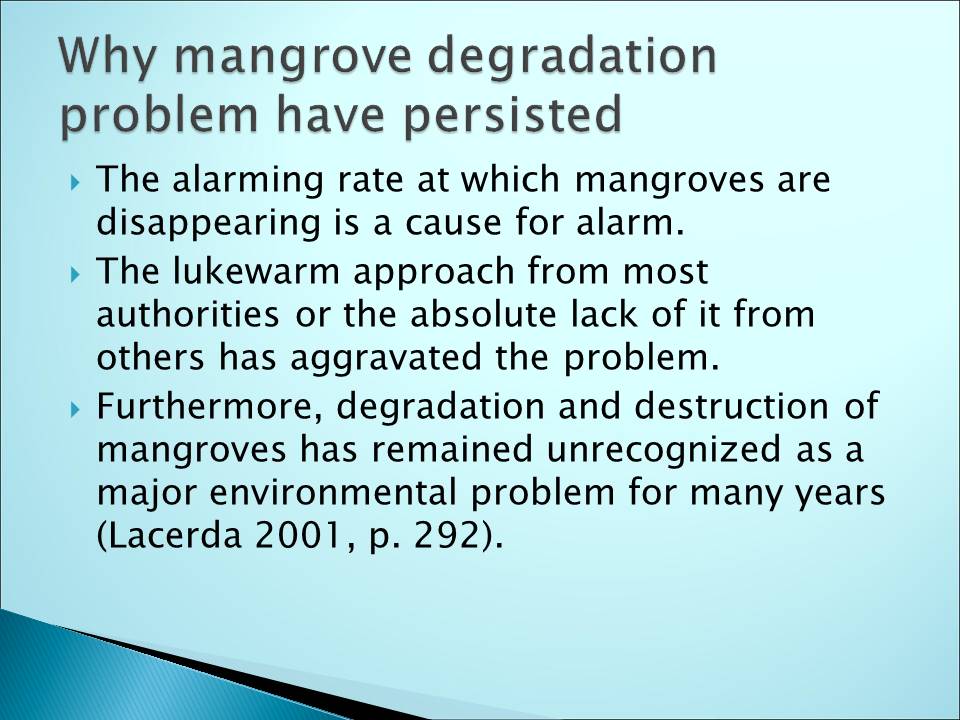Introduction
Mangroves grow in humid tropical areas that are sheltered from the wave and tidal activities of the ocean (Lacerda 2001, p. 292).
They are very important in the ecosystem yet they are most threatened in tropical ecosystems (Lacerda 2001, p. 294).
Initially, mangrove forests were estimated to have covered over 18.1 million hectares of land (Finlayson et al 2002, p. 67).
Many countries including Cuba, the US, Thailand, Malaysia and regions like East Africa have lost significant portions of their mangroves (Finlayson et al 2002, p. 67).
Alvarez‐Leon (2001, p. 67) emphasize that if the current rate of mangrove destruction is left unwatched they will disappear in less than 100 years.



Causes of mangrove degradation
Both human and natural environmental factors have contributed to the degradation of mangroves globally (Lacerda 2001, 292).
Degradation however mainly takes place through human activities.
According to Kathiresan (2000, p. 185) human activities that have contributed to mangrove degradation include; oil exploration, building and construction of tourist facilities and exploitation of the forests for firewood.

Importance of mangrove forests
- Mangrove forests are the most important coastal ecosystems in the world both in terms of production and coastal protection (Lacerda 2001, 294).
- They stabilize shoreline and prevent erosion of coastal shores by tapping sediments.
- They provide habitat for a variety of marine and terrestrial life.
- Additionally, they provide secure breeding places for many coral reefs and fish species.
- Mangroves also protect the coastal land areas from erosion that threaten loss of life and property (Finlayson et al 2002, p. 67).


Why mangrove degradation problem have persisted
- The alarming rate at which mangroves are disappearing is a cause for alarm.
- The lukewarm approach from most authorities or the absolute lack of it from others has aggravated the problem.
- Furthermore, degradation and destruction of mangroves has remained unrecognized as a major environmental problem for many years (Lacerda 2001, p. 292).
- Lack of organized and sustainable harvesting of the mangroves have led to the decline of mangroves (Primavera & Esteban, 2008, p. 350).
- Additionally, lack of informed approaches in the commercial exploitations of mangroves (Mastaller, 1996, p. 51).
- Lack of informed visionary approach among stakeholders hinder conservation practices.
- According to Kathiresan (2000, p. 185), mangrove degradation is likely to continue if nothing is done to sensitive people of the dire consequences of their actions.
- Human populations are still expanding and encroaching on the existing mangrove lands.
- Moreover, human continue to dump waste along these coastal regions (figure 4) oblivious of the consequences of their actions.




Consequences of mangrove degradation
- Mangrove deforestation have led to fisheries decline.
- Degradation of clean water supplies.
- Salinization of coastal soils.
- Increased release of carbon dioxide into the atmosphere.
- Coastal erosion because destruction of Mangroves leaves the land exposed to waves whose energy would have otherwise been stopped by the large roots and stems.
- Loss of life and property incase of natural calamities such as tsunamis and storm surge.
- Adverse effects of tsunami greatly felt in areas such as Indonesia, Malaysia, Thailand, Myanmar, Bangladesh, India where extensive destruction of mangrove is present .
- For example, in India’s Tamil Nadu state, the impact of the tsunami was less on the human settlements located behind mangrove forests (Mishra, 2005,par. 5).



Case studies of mangrove restoration activities
- As shown in figure 5 above ocean line encroachment is a threat to mangrove forests.
- Florida government has come up with legislation measures to protect mangrove forests from human damage (Primavera & Esteban, 2008, p. 350).
- The enacted law in Florida requires people to obtain permits before they can interfere with mangrove forests in any way.
- These measures have reversed the negative trend of mangrove degradation; hence Florida residents and species can reap the benefits of this ecosystem.
- Authorities in Andhra Pradesh have come up with canal techniques to conserve and manage the remaining mangrove forests (FAO, 2001, p.23).
- The mangroves in this region had been degraded due to timber extraction, fisheries and aquaculture activities and pollution through poor waste disposal
- Restoration were conducted by involving the neighboring community who were trained how to dig canals and nursery raising.
- Restoration have impacted positively Andhra Pradesh bio-diversity.


Methodology
- This research will use both primary and secondary data.
- Primary data will be collected by use of direct interviews and questionnaires.
- Managers from the forestry department in Australia will be a significant source of primary data.
- Secondary data will be collected by analyzing existing literature on the management of degraded mangroves.

Conclusion and Recommendations
Mangrove degradation is a significant environmental problem that need immediate concern.
The fact that human continue to destroy mangrove forests without being aware of the consequences shows there is need for awareness campaigns.
Therefore, governments should borrow an example from regions like Florida and India that indicate positive conservation measures.

References
Alvarez‐Leon, R. 2001. Las Tortugas marinas de Colombia: estado actual de su conocimiento. Rev. Acad. Columbi. Cienc., 25(95): 269‐286.
Clarke, K.R. & Warwick, R.M. 2001. Changes in marine communities: an approach to statistical analysis and interpretation. Plymouth: PRIMER‐E.
Duke, N.C et al. 2007. A world without mangroves? Letters. Web.
FAO. 2001.Global Forest Resources Assessment 2000: Main report. FAO Forestry Paper 140. Rome. Web.